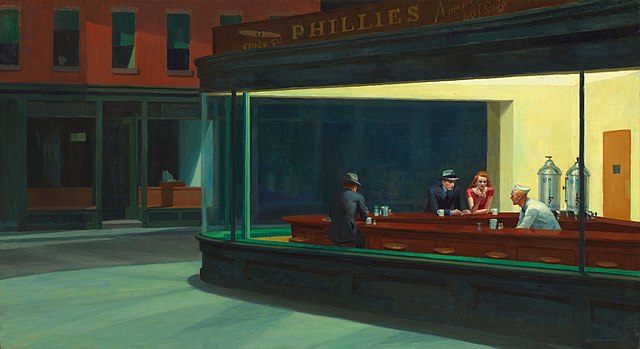Edward Hopper’s iconic painting “Nighthawks,” created in 1942, is a masterpiece of American art that captures the feeling of urban solitude and offers a glimpse into the stories of its enigmatic characters. The painting has long been a subject of fascination and interpretation, and it’s ripe with hidden narratives and symbolism. Here’s a look at some of the stories behind “Nighthawks”:
Urban Alienation:
“Nighthawks” is often seen as a representation of urban alienation. The customers in the diner appear to be isolated and disconnected from one another, lost in their thoughts, creating a sense of loneliness and solitude. This can symbolize the isolation that can come with urban living.
Time of Day:
The nighttime setting, with its stark fluorescent lighting, can be symbolic of the passage of time and the idea that life goes on even in the darkest hours. It suggests that people are drawn to this diner not only for sustenance but also for companionship during these late hours.
Unspoken Stories:
The characters in the painting have their backs turned to the viewer, leaving their stories untold. Viewers are left to imagine the lives, thoughts, and emotions of these individuals. The artist encourages the viewer to engage in storytelling and speculation, making “Nighthawks” a captivating and interactive work of art.
War and Isolation:
The painting was created during World War II when there was a strong sense of uncertainty and fear. The solitary figures can be seen as a reflection of the wartime atmosphere, with individuals seeking refuge from the outside world. It may symbolize the sense of isolation and vulnerability experienced during the war.
Gender and Relationships:
The lone waitress and the man sitting at the counter may symbolize themes of gender and relationships. The man could be a regular customer, and the waitress might represent a sense of fleeting connection or companionship. This raises questions about the dynamics between the characters.
American Identity:
“Nighthawks” has been interpreted as a representation of American culture and identity. The diner is often seen as an archetypal American setting, and the painting may symbolize the enduring American spirit of resilience in the face of adversity.
Absence of Escape:
The large, uninviting windows in the painting can be seen as symbolic of the characters’ inability to escape their circumstances or the harsh realities of their lives. They are trapped in a lonely, sterile environment.
Universal Loneliness:
“Nighthawks” has resonated with viewers around the world, regardless of culture or language. Its portrayal of human isolation and the desire for connection is a universal theme that transcends borders and time periods.
In summary, “Nighthawks” by Edward Hopper invites viewers to unmask the stories behind its characters and the hidden narratives that unfold in its evocative urban setting. It continues to captivate and inspire interpretations, serving as a poignant and enduring work of art that reflects the complexities of human existence and the longing for connection amidst urban solitude.










